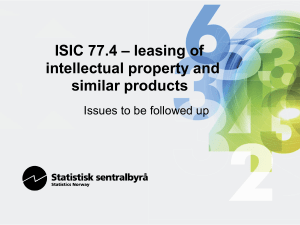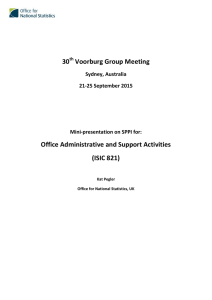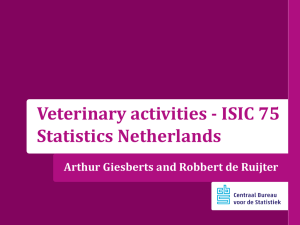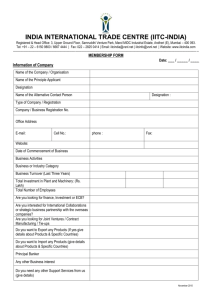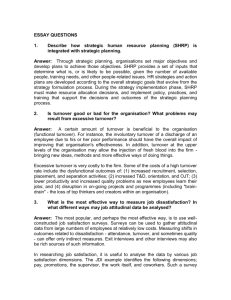Turnover and output regarding Organisation of conventions and tradeshows Paper VG ‘15
advertisement
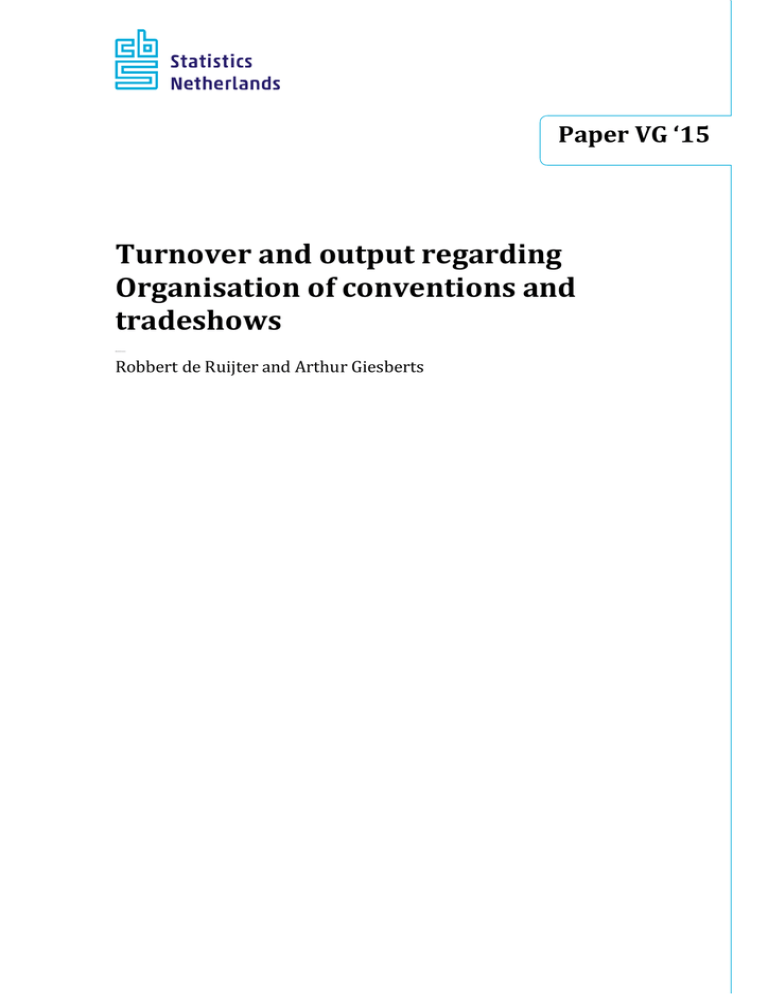
Paper VG ‘15 Turnover and output regarding Organisation of conventions and tradeshows administat ionveter Robbert de Ruijter and Arthur Giesberts CBS Den Haag Henri Faasdreef 312 2492 JP The Hague P.O. Box 24500 2490 HA The Hague +31 70 337 38 00 www.cbs.nl project number EBD September 2015 remarks The views expressed in this paper are those of the author(s) and do not necessarily reflect the policies of Statistics Netherlands. Index 1. Introduction 4 2. Definition of service being collected 4 2.1 2.2 4 4 Classifications Organisation of conventions and tradeshows 3. Unit of measure to be collected 5 4. Market conditions and constraints 6 4.1 4.2 6 7 Available statistics Organisation of conventions and tradeshows: current market situation 5. Standard classification structure and product detail/levels 12 6. Evaluation of standard vs. definition and market conditions 12 7. NA concepts and measurement issues 13 8. Turnover/output data method(s) and criteria 14 9. Comparability of turnover with price index 15 10. Summary 16 Turnover and output regarding Organisation of conventions and tradeshows 3 1. Introduction This report contains information on the size, turnover, employment, prices and other statistics of the organisation of conventions and tradeshows in the Netherlands and the use thereof for the National Accounts. Furthermore it outlines briefly the main statistical processes and some issues and challenges within these processes as well as some new developments. 2. Definition of service being collected 2.1 Classifications The Dutch Standard Enterprise Classification (SBI 2008 Version 2014) is based on the activity classification of the European Union (Nomenclature statistique des Activités économiques dans la Communauté Européenne, NACE Rev. 2) and on the classification of the United Nations (International Standard Industrial Classification of All Economic Activities, ISIC Rev. 4). The first four digits of the SBI 2008 Version 2014 are identical to the four digits of NACE Rev. 2. Furthermore the first three digits of the SBI 2008 Version 2014 and NACE Rev. 2 are the same as the first three digits of ISIC Rev 4. A possible fifth digit in SBI 2008 Version 2014 is for a Dutch differentiation. Table 1 Organisation of conventions and tradeshows ISIC Rev. 4 NACE Rev. 2 SBI 2008 Description 82 82 82 Office administrative, office support and other business support activities 82.1 82.1 82.1 Office administrative and support activities 82.2 82.2 82.2 Activities of call centres 82.3 82.3 82.3 Organisation of conventions and tradeshows 82.9 82.9 82.9 Other business support activities n.e.c. 2.2 Organisation of conventions and tradeshows The ISIC class 82.3 Organisation of conventions and tradeshows is part of ISIC division 82 Office administrative, office support and other business support activities. ISIC division 82 is part of ISIC section N Administrative and support service activities. The ISIC division 82 includes the provision of a range of day-to-day office administrative services, as well as ongoing routine business support functions for others, on a contract or fee basis. This division also includes all support service activities typically provided to businesses not elsewhere classified. Units classified in this division do not provide operating staff to carry out the complete operations of a business. 82.3 Organisation of conventions and tradeshows This class includes the organisation, promotion and/or management of events, such as business and tradeshows, conventions, conferences and meetings, whether or not including the Turnover and output regarding Organisation of conventions and tradeshows 4 management and provision of the staff to operate the facilities in which these events take place. Other classes under ISIC division 82 are: 82.1 Office administrative and support activities This group includes the provision of a range of day-to-day office administrative services, such as financial planning, billing and record keeping, personnel and physical distribution and logistics for others on a contract or fee basis. This group includes also support activities for others on a contract or fee basis, that are ongoing routine business support functions that businesses and organizations traditionally do for themselves. Units classified in this group do not provide operating staff to carry out the complete operations of a business. Units engaged in one particular aspect of these activities are classified according to that particular activity. 82.2 Activities of call centres This class includes: activities of inbound call centres, answering calls from clients by using human operators, automatic call distribution, computer telephone integration, interactive voice response systems or similar methods to receive orders, provide product information, deal with customer requests for assistance or address customer complaints activities of outbound call centers using similar methods to sell or market goods or services to potential customers, undertake market research or public opinion polling and similar activities for clients. 82.9 Business support service activities n.e.c. This group includes the activities of collection agencies, credit bureaus and all support activities typically provided to businesses not elsewhere classified. 82.91 Credit rating and bill collection 82.92 Packaging, sorting etc. on a fee or contract basis 82.99 Other business support activities n.e.c. 82.991 Auctions for agricultural and fish products 82.992 Auctions for household goods, art, antiques, machinery and similar goods 82.999 Other business services n.e.c. 3. Unit of measure to be collected Statistics on the organisation of conventions and tradeshows are (potentially) based on surveys and administrative resources of enterprises registered under ISIC class 82.3 Rev. 4 at the Dutch Chamber of Commerce. The enterprise, employing at least one person for 15 hours work or more, is used as the statistical unit. Given the characteristics of this branch the enterprise coincides well with the Kind of Activity Unit (KAU) preferred for turnover statistics. For the most important statistics (SBS and STS), survey samples and administrative resources are analysed and published at the ISIC division 82 aggregate instead of ISIC class 82.3. Analysis and publication at ISIC class 82.3 is not compulsory for the Netherlands according to Eurostat rulings. Turnover and output regarding Organisation of conventions and tradeshows 5 STS turnover is defined as net turnover, proceeds from sales, excluding value-added tax (VAT), deducting discounts, premiums, deposits and freight charges. STS turnover statistics may include turnover of secondary activities too. On the other hand organisation and tradeshow activities that are secondary activities of enterprises that are not part of ISIC division 82 are not included in STS turnover statistics of ISIC division 82. Within SBS statistics revenues from secondary activities can partly be distinguished. 4. Market conditions and constraints 4.1 Available statistics In table 2 the statistical information which is available for ISIC division 82 and ISIC class 82.3 is shown. Business Demography Turnover STS Operating returns/costs SBS PPI/SPPI/CPI Sentiment surveys Bankruptcies Table 2 Available statistical information on ISIC class 82.3 and ISIC division 82 82 Office admin., office support and other business support activities Y Y Y N Y Y 823 Organisation of conventions and tradeshows Y N N N Y Y Statistic Sector/branches (SIC 2008) Business demography These are quarterly statistics on the number of enterprises, by size class and legal form. Business demography data of ISIC division 82 and ISIC class 82.3 are available from the first quarter of 2007 and new data are published in the first month of each quarter. The most important data sources for business demography are registers of the Dutch Chamber of Commerce and registers of the Tax Department. Structural Business Statistics (SBS) At Statistics Netherlands SBS statistics are only available for ISIC division 82. No data are published for ISIC class 82.3 organisation of conventions and tradeshows. The annual SBS statistics at ISIC division 82 consists of data on production, employment, operating returns and costs. SBS data for office administrative, office support and other business support activities in the current format are available from 2010 onwards. The most recent year is 2013. The data for 2014 will be available in March or the beginning of April 2016. For SBS statistics a combination of a sample survey and a census (large size classes) is being used. Short Term Statistics (STS) Turnover (and production volume) At Statistics Netherlands STS turnover statistics are only available for ISIC division 82. No data are published for ISIC class 82.3. The quarterly turnover statistics are based on 2010 = 100. The index of turnover statistics on office administrative, office support and other business support Turnover and output regarding Organisation of conventions and tradeshows 6 activities starts in 2005 and turnover change statistics are available from the first quarter of 2006. Currently no quarterly production volume statistics are available for office administrative, office support and other business support activities nor for organisation of conventions and tradeshows. STS turnover is for the greater part measured by using VAT-data. Apart from the VAT-data a rather small sample survey is being used. Short Term Statistics (STS) Price change Within Statistics Netherlands no SPPI is available for ISIC division 82 nor for ISIC class 82.3. As the whole branch is about B2B services no price change information is available in the CPI either. Business Sentiment Survey This quarterly statistic is set-up to provide current information on the opinions of Dutch producers within the organisation of conventions and tradeshows branch, about performance and expectations concerning their enterprises. The Business sentiment survey makes it possible to identify turning points in business sentiment at an early stage. In this way a change in the trend of economic activity of Dutch companies is available at an early stage. The questions that are asked to the companies relate to production, sales, prices, orders, stocks, investment, competitiveness, economic climate, workforce and the factors limiting production. Data on ISIC class 82.3 are available from reference period 2014 Q1 onwards. Bankruptcies Data on bankruptcies is available monthly, quarterly and annually at ISIC class 82.3 level. The current data series on bankruptcies starts from 2009. National Accounts The National Accounts provide information on production, intermediate consumption and value added for ISIC division 82 on office administrative, office support and other business support activities. National accounts tables are available quarterly and annually. The most recent National Accounts annual estimate is 2014. These are partly based on extrapolations of the 2013 accounts, using STS turnover . The annual estimates for 2013 are based on among others the SBS statistics of 2013 and are therefore more reliable. 4.2 Organisation of conventions and tradeshows: current market situation Business demography rd In the 3 quarter of 2015 ISIC class 82.3 contained 1 170 enterprises, 690 of which were personally owned and only 480 privately or publicly quoted joint stock enterprises. Almost all enterprises are small and more than three quarters (930) have only one person employed. ISIC division 82 contained 10 775 enterprises, 8 880 were personally owned and only 1 900 were privately or publicly quoted joint stock enterprises. Almost all enterprises are small and more than 85% have only one person employed. Structural Business Statistics (SBS) The SBS 2013 statistics of ISIC division 82 are based on a sample of approximately 110 enterprises, all from size class medium and large. The total response rate was just over 80%. For the size class of small enterprise the structure of previous years was used and confronted with Turnover and output regarding Organisation of conventions and tradeshows 7 STS turnover change of the same size class based on VAT registers. This approach is used for both administrative burden reasons as well as for efficiency. Each year only an alternating part of all ISIC divisions in the small size class are actual being sampled for SBS. In table 3 a selection of the data of ISIC class 82.3 is presented. The data are presented by size class and as totals. Please note that these are not officially data as the official publication is at ISIC division 82 level Table 3 SBS data by size class Enterprises Organisation of conventions and tradeshows: ISIC 82.3* Values x € 1 000 Size Total % Small % Small % Medium % Large All Persons employed < 10 10 < 50 50 < 250 250 > # Enterprises 1 029 990 30 8 1 # Persons employed 5 197 2 460 929 1 139 669 # Persons employed in FTE 4 321 2 082 783 832 625 Turnover 590 865 142 410 110 749 221 082 116 625 Value added 244 259 59 877 39 927 93 048 51 407 Personnel costs 159 561 32 714 39 465 50 614 36 768 Total costs 519 747 121 264 110 379 178 558 109 547 Source: Structural Business Statistics, NACE Rev. 2, 2013 * The 82.3 data is provisional data for the purpose of this report only and not to be cited. The table above illustrates that turnover of ISIC class 82.3 is rather equally spread over the different size classes. Also the structure of the different size classes is more or less comparable. The graph underneath demonstrates the distribution of turnover by size classe. Figure 1 Turnover by size class of ISIC class 82.3* Enterprises and turnover by size (persons employed) 100% 90% 80% 70% 60% 50% 40% 30% 20% 10% 0% Large 250 > Medium 50 < 250 Small 10 < 50 Small < 10 empl. # Enterprises Turnover Source: Statistics Netherlands - SBS + Business demography 2013 * The 82.3 data is provisional data for the purpose of this report only and not to be cited. Turnover and output regarding Organisation of conventions and tradeshows 8 Figure 2 Net turnover of office administrative, office support and other business support activities Net turnover x billion Euro 4,2 4 3,8 3,6 3,4 3,2 2010 2011 2012 2013 Source: SBS, NACE rev. 2, 2013 The SBS statistics clearly indicate a substantial growth in turnover in the last two years after a dip in 2011. Short Term Statistics (STS) Turnover Figure 2 contains the index of STS turnover of office administration, office support and other business support activities (ISIC division 82), including organisation of conventions and tradeshows (ISIC class 82.3). Over the past few years turnover has gradually grown. Furthermore a clear seasonal pattern can be noticed. Figure 3 Turnover change of office administrative, office support and other business support activities Quarterly turnover changes (index 2010 = 100) 130 120 110 100 90 80 70 I II III IV I II III IV I II III IV I II III IV I II III IV I 2010 2011 2012 2013 2014 II 2015 Source: Statistics Netherlands Statistics Netherlands doesn’t have a survey to collect volume changes of ISIC division 82 or ISIC class 82.3. Production volume isn’t published separately yet, though for other branches like ISIC division 55 or division 56 we do. The National Accounts approximates volumes by using turnover data combined with deflators. Turnover and output regarding Organisation of conventions and tradeshows 9 Short Term Statistics (STS) Price change No information on price change is available for ISIC class 82.3 nor for ISIC division 82. A study has been done in 2013 to determine the feasibility of such a price index. Implementation is depending on the introduction of FRIBS by Eurostat and decision taking by Statistics Netherlands. The study based on a Eurostat Grant research looked at the feasibility of an SPPI for ISIC division 82 including ISIC class 82.3. In conclusion, based on the meetings with representatives and the test surveys, a model price method which can be based on repeated services is the best method for this class of services. However, it will take a lot of time and effort to inform respondents properly, and to convince them to report prices. The resulting SPPI would be more useful as a year-on-year than a quarter-on-quarter price change indicator, because tradeshows and fairs are not repeated every quarter, but every year or two years. So the SPPI may not be useful as a short-term deflator or should at least be used with caution. Business Sentiment Survey The entire business survey consists of approximately 10 variables, some of which are presented in the table underneath. In this case the expectations for the next quarter are listed, but data on sentiments of the past quarter is available too. In the second quarter of 2015 entrepreneurs within ISIC class 82.3 were very pessimistic about the forthcoming quarter. The majority is negative about turnover, expected orders, persons employed and the economic climate. A seasonal pattern can only partly justify these negative sentiments. Figure 4 Business sentiments for organisation of conventions and tradeshows Balance % positive and negative answers: 2015 III 40 30 20 10 0 -10 -20 -30 -40 -50 Turnover 2014 III Expected orders 2014 IV Workforce 2015 I 2015 II Economic climate 2015 III Source: Statistics Netherlands Turnover and output regarding Organisation of conventions and tradeshows 10 Bankruptcies Data on bankruptcies is available for organisation of conventions and tradeshows. The number of bankruptcies is rather small given the amount of enterprises in ISIC class 82.3. Figure 5 Number of bankruptcies in organisation of conventions and tradeshows Number of bankruptcies 14 12 10 8 6 4 2 0 2009 2010 2011 2012 2013 2014 Source: Statistics Netherlands National Accounts The contribution to GDP of office administrative, office support and other business support activities is rather small in the Netherlands. For 2014 National Accounts estimate production of office administrative, office support and other business support activities at basis prices at € 3 838 million and gross value added at € 1 927 million. The gross value added is approximately 0,33% of total value added. A very rough estimate is that the contribution of organisation of conventions and tradeshows in this total is 10-15 percent. Gross value added of ISIC class 82.3 would therefore be approximately 0,05%. Table 4 Production, intermediate consumption and value added SIC 82 2010 2011 2012 2013** 2014* Production basic prices mln euro Intermediate consumption (-) mln euro Gross value added basic prices mln euro 3727 3545 3547 3617 3838 1811 1711 1768 1818 1911 1916 1834 1778 1798 1927 * provisional figures Turnover and output regarding Organisation of conventions and tradeshows 11 5. Standard classification structure and product detail/levels In the Netherlands no further statistical breakdown is available for SBS and STS statistics than ISIC division 82. Some statistics are available at the more detailed level of ISIC class 82.3. More detailed statistics than ISIC class 82.3 are not available however. Table 5 CPA (2008) breakdown of ISIC class 82.3 CPA Description 82.30 Convention and tradeshow organisation services 82.30.1 Convention and tradeshow organisation services 82.30.11 Convention organisation services 82.30.12 Tradeshow organisation services 6. Evaluation of standard vs. definition and market conditions Sector description Many small companies (less than 10 employees) are active in this services class, some dedicated to a niche market or even to just one fair or convention, others providing general organisation services. But the less than 1 percent large and medium-sized companies generate more that 50 percent of the turnover. The mainly business to business services that this sector delivers are very sensitive to trends in society. These days people wish to be included in an event, to belong to a certain exclusive group or subculture and want to be acknowledged and be in touch through digital media. This translates itself to the sector by the change of more and smaller conventions or events and the growth in exclusive on-site services and added communication services via blogs, Facebook, etc. Digitalisation has also led to an increase in virtual tradeshows, i.e. temporary or permanent online meeting points for businesses in a certain trade. These virtual tradeshows are still seen as an additional service to the live communication tradeshows. In addition to these trend changes there is also a drive towards international business change for company growth. The larger organisers of conventions export successful convention formats and even organise conventions, tradeshows and events in foreign locations abroad. The two sub-categories of this class are very similar in the services they provide, but the markets are different. Convention organisation services are B2B in the sense that businesses pay the convention organiser for a stand and use extra services, but they are also B2C in the sense that consumers buy tickets to visit the convention. Tradeshow organisation services are fairly limited to B2B, but there are a few hybrid tradeshows with restricted and public access. The turnover that SN measures in this class is not limited to organisational services. The companies that own the convention centres organise conventions and provide organisational Turnover and output regarding Organisation of conventions and tradeshows 12 services to third parties, but they also organise cultural/entertainment events and rent out the exhibition halls. The rental services actually belong to CPA 68.20.12 ‘Rental and operating services of own or leased non-residential real estate’. The organisation of cultural/entertainment events belongs to CPA 90.02.12 ‘Performing arts event promotion and organisation services’. STS and SBS statistics of ISIC class 82.3 Technically it would be relatively easy to process and publish STS turnover statistics on a quarterly basis for ISIC class 82.3 organisation of conventions and tradeshows. However it is not compulsory for Eurostat. In such cases Statistics Netherlands limits the processing and publication of non-compulsory statistics to an absolute minimum for efficiency and administrative burden reasons. Technically it would also be relatively easy to process and publish SBS turnover statistics on an annual basis for ISIC class 82.3 organisation of conventions and tradeshows. However it is not compulsory for Eurostat. In such cases Statistics Netherlands limits the processing and publication of non-compulsory statistics to an absolute minimum for efficiency and administrative burden reasons. 7. NA concepts and measurement issues The National Accounts provide annually and quarterly statistical information on production, intermediate consumption and value added for ISIC division 82 as shown in table underneath. The National Accounts use source statistics like the SBS and STS turnover figures to compile macro figures. The methodology used in source statistics may differ from the concepts used in the National Accounts. Moreover some items, which are not covered by source statistics, are included in National Accounts. Source statistics and National Accounts both have a sort of autonomy. As original levels (f.i. due compilation timing) differ and maintaining growth rates is considered as more important, levels of output, but also other variables may differ. For example within SBS all revenues (including turnover of trade activities) are included. Within National Accounts only the margins of trade activities are counted as production (in accordance with ESR). For that reason alone turnover within SBS is in general higher than within National Accounts. Another example is that STS estimates of turnover and production volume focus at accurate estimation of the business cycle within each branch. National Account focus at the correct measurement of the total economy and works more explicitly according to the registered classifications. Therefore within the Netherlands two series of turnover statistics are being produced. The turnover series that is being published differs from the series that is being delivered to the National Accounts department in the way it handles administrative changes such as take overs and ISIC classification changes. In conclusion the timing, methodology and concepts used in source statistics may differ from the National Accounts practices, thus resulting in differences. Turnover and output regarding Organisation of conventions and tradeshows 13 8. Turnover/output data method(s) and criteria In the Netherlands for many branches STS and SBS estimates are interlinked thus enhancing the consistency of both and the quality of National Accounts. The linkage consists of the use of the year total of turnover from the quarterly VAT-data as a boundary for the SBS statistics: the results of the SBS surveys are raised to correspond to the already known turnover total of the VAT-data. Using this constraint the SBS turnover is equal to the STS turnover estimates and the other information on cost and revenue structure will fit without major adjustments. Furthermore within the Netherlands a dedicated department (ConGO) deals with consistency of data (SBS, STS, FATS, etc.) of complex and large enterprises. Both the source statistics and the National Accounts benefit from this early quest for consistency. SBS details The sample size may differ strongly per year as the Netherlands is forced to produce statistics efficiently and with minimal administrative burden. Therefore SBS surveys among small enterprise are mostly held once every few years. In other years STS turnover estimates and the structure of the previous year is used to estimate SBS statistics for the current year. STS turnover details Turnover statistics at Statistics Netherlands are predominantly based on VAT-data. Surveys are being used only for complex and large enterprises. Underneath some process details of the estimation of turnover of ISIC division 82 and ISIC class 82.3 are presented to illustrate the type and amount of data used. Table 6 Process details turnover statistics Turnover process details 2015 Q2 # ISIC 82 Number of enterprises Enterprises surveyed Enterprises with VAT records (turnover > 0) Percentage with Quarter-on-Quarter turnover > 0 Births (both administrative and actual) Deaths (both administrative and actual) # ISIC 82.3 11 041 1 200 43 10 8 063 885 90% 67% 1 041 95 561 80 The current publication of the ISIC division 82 turnover statistics is based on quarterly Year-onYear changes. Only real business cycle related changes are taken into consideration; effects of administrative changes (like take-overs or ISIC classification changes) are merely overruled. Working day adjustment analysis didn’t have significant results. Regular Year-on-Year changes and working day adjusted Year-on-Year series are therefore identical. In 2016 the ISIC division 82 turnover publications might be extended with seasonal corrected Quarter-on-Quarter changes as turnover of ISIC division 82 tends to have a seasonal pattern. The periodicity of turnover statistics might change around 2018 as a result of the new Eurostat FRIBS programme. FRIBS requires member states to publish both turnover and production volume on a monthly basis for most ISIC divisions. Turnover and output regarding Organisation of conventions and tradeshows 14 This is a major challenge for Statistics Netherlands as the current process based on quarterly VAT- data is no longer feasible. At the moment research takes place to base estimates on nowcasting techniques, the available monthly VAT-data and simulation of monthly turnover surveys among a limited number of crucial enterprises. Another new change is about experiments with the use of Standard Business Reporting (SBR: system2system communication) in combination with what we call Reference General ledger System (RGS: a sort of bookkeeping Esperanto). The idea is to use massive dumps by bookkeeping or accountant firms of their clients annual business accounts. We expect this to work well for smaller enterprises both for STS and SBS statistics. STS price details In the Netherlands no SPPI data on ISIC division 82 or ISIC division 82.3 are available. As from or later 2018 the production of an SPPI for ISIC 82 might become compulsory for Statistics Netherlands as Eurostat will introduce by that time the new FRIBS regulations. 9. Comparability of turnover with price index The turnover that can be measured in this class is not limited to organisational services as secondary activities may occur. The companies that own the convention centres organise conventions and provide organisational services to third parties, but they also organise cultural/entertainment events and rent out the exhibition halls. The rental services actually belong to CPA 68.20.12 ‘Rental and operating services of own or leased non-residential real estate’. The organisation of cultural/entertainment events belongs to CPA 90.02.12 ‘Performing arts event promotion and organisation services’. As no SPPI of ISIC division 82 of class 82.3 is available the National Accounts use the SPPI of ITservices as a deflator. As this is not a very good match, currently the SPPI for 70.2 is being considered. Also the National accounts uses wages as determined in collective labour agreements as an reference indicator. Pricing methodology This section describes the nationally preferred pricing methods, summarises methods used internationally, and compares costs and benefits of these methods. Discussions with representatives from the trade pointed out that the pricing of convention and tradeshow organisation services is quite difficult. Several parties are involved for services like renting the convention hall, marketing, parking, security, IT, hosting, stand building, audiovisual, catering, organising, etc. The organising services provider can act as an intermediary between the exhibitor and all or a selection of third-party suppliers, in the latter case leaving room for the exhibitor to create the convention experience it wants. This means that the price an organisation services provider charges includes all costs for the third party services they cover. With this package of services it is hard to separate the price for the organisational services alone, in other words to calculate a net price. A gross price is more appropriate in this case, i.e. the price measured includes all cost components from third party services that are contracted by the organisational services provider. Another complicating matter is that in some cases the exhibitors receive a discount or refund Turnover and output regarding Organisation of conventions and tradeshows 15 that depends on the total amount of revenues from consumer ticket sales. And last but not least, while the core activity of organisation services provided may not differ fundamentally from quarter to quarter, the conventions and tradeshows do. So the services that an exhibitor pays for vary from convention to convention, which means that the package of services represented in the gross price of the organisation service is different from quarter to quarter. Creating a representative fictional constant model for an organisation services provider would rule out unrealistic price changes caused by the differences between the conventions they organise. But the issue with a fictional model is that the respondent would have to get prices from all third-party suppliers to create a proper price quotation. This would mean that the administrative burden would be multiplied, which is not a desirable situation. SN prefers a method of actual transaction prices to keep the administrative burden as minimal as possible. Organisation services providers would have to find one or more representative convention(s) or tradeshow(s) for each quarter. The respondent reports prices for the current activities each quarter, the rest would be imputed. This method would require an initial period for each new respondent in which prices for the services in the quarters of the previous year are fixed. The package of services belonging to the organisation of a convention needs to be well specified for the SPPI, in order to have the information required for quality adjustment if the package changes. This means that companies report the price determining factors, e.g. square metres of the venue, and services included, e.g. parking, IT, construction, cleaning, catering, wardrobe, first aid post ,etc. Conclusion A model price method which can be based on repeated services is the best method for this class of services. However, it will take a lot of time and effort to inform respondents properly, and to convince them to report prices. The resulting SPPI would be more useful as a year-on-year than a quarter-on-quarter price change indicator, because tradeshows and fairs are not repeated every quarter, but every year or every second year. So the SPPI may not be useful as a short-term deflator or should at least be used with caution. This is the conclusion of the research by Statistics Netherlands. SN didn’t implement the model price method because of the complexity of this specific group of companies. 10. Summary STS and SBS statistics are only available at ISIC division 82 level. No data is analysed at ISIC class 82.3 level. STS turnover is almost exclusively measured by using VAT-data. Besides VAT-data a rather small sample survey is being used. For SBS statistics a combination of a sample survey and a census (large size classes) is being used. The STS and SBS figures are published at ISIC division 82 level. This information is also used on a quarterly or annually basis by the National Accounts to calculate volume change. A known issue is the lack of an SPPI for ISIC division 82 or class 82.3. Such a SPPI might be developed after 2018 as a consequence of the introduction of the Eurostat FRIBS programme. Differences with National Accounts will remain due to among other different concepts. Turnover and output regarding Organisation of conventions and tradeshows 16 It is not likely that statistics of ISIC class 82.3 will be elaborated further (unless for paying clients) as there is no obligation from the future Eurostat FRIBS programme for STS statistics and because the contribution to GDP is rather small. Some new developments take place from which the SBS and or STS statistics may benefit. Examples are the interlinked and consistent methodology for STS and SBS turnover and the future use of system2system dumps of annual accounts. Turnover and output regarding Organisation of conventions and tradeshows 17
